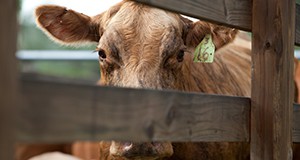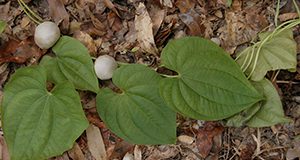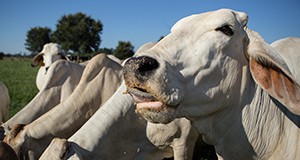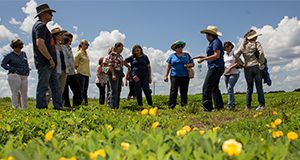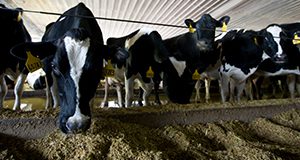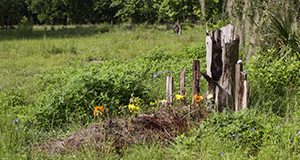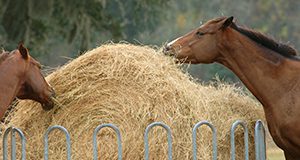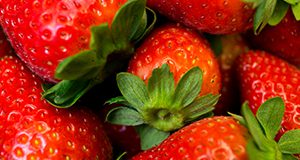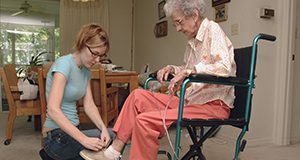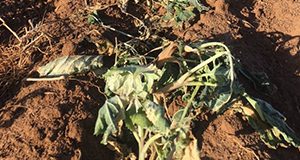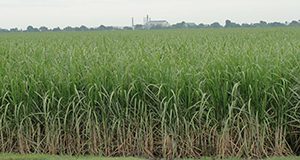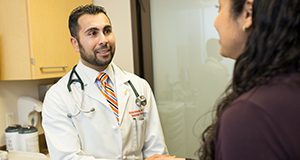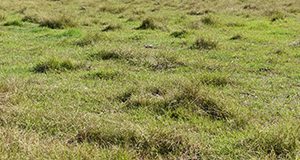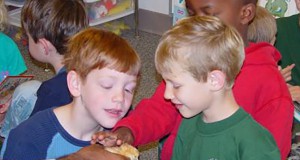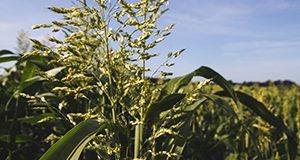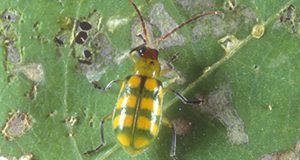Body condition score (BCS) is both a good indicator of the past nutritional status of a cow and a way to determine future nutritional needs. The BCS technique is easy to learn and can help with management decisions. This new 5-page fact sheet discusses reasons to measure BCS, ways to evaluate BCS, and important assessment times. Written by Matt Hersom and Todd Thrift, and published by the UF/IFAS Department of Animal Sciences, August 2018.
http://edis.ifas.ufl.edu/an347
Author: Amanda Quintos
Integrated Management of Non-Native Plants in Natural Areas of Florida
While natural areas are conservation lands that have been set aside for the purpose of preserving (or restoring) native plant and animal communities, they do require active management. One of the greatest management issues in natural areas is invasive plants. This 35-page publication provides land managers in Florida with current methods used to manage non-native plants. Written by Stephen F. Enloe, Ken Langeland, Jason Ferrell, Brent Sellers, and Greg MacDonald, and published by the UF/IFAS Agronomy Department, revised July 2018.
http://edis.ifas.ufl.edu/wg209
Mycotoxins in Florida Pastures
Beef cattle producers in Florida have expressed concerns about the potential presence of mycotoxins in summer perennial forages. In other regions of the US, mycotoxins in forage crops have caused productivity and economic losses. This 3-page fact sheet provides information about the current state of knowledge regarding mycotoxins in Florida perennial grass pastures. Written by Marcelo Wallau, Brittany Justesen, Ann Blount, Luiz Ferraretto, Glen Aiken, and Aaron Stam, and published by the UF/IFAS Agronomy Department, August 2018.
http://edis.ifas.ufl.edu/ag422
Clearing Up Charitable Giving
Life is filled with uncertainty. When disasters or hard times arise, individuals often become vulnerable and feel helpless and confused. After the initial shock, people start to wonder how they can help. When we feel moved to donate, we should take steps to confirm that our gifts are going exactly where we intended them to go. This 3-page fact sheet discusses impulse giving, ways to avoid it, phone solicitations, mail fraud, resources for accurate information on charitable organizations, and steps to take if one falls victim to a scam. Written by Lynda Spence, and published by the UF/IFAS Department of Family, Youth and Community Sciences, August 2018.
http://edis.ifas.ufl.edu/fy1479
Strip-Planting Rhizoma Peanut into Grazing Systems
Nitrogen (N) is one of the major off-farm inputs in livestock systems, either in the form of N fertilizer or purchased feed. Fortunately, you can reduce those expenses by growing your own nitrogen using forage legumes. Rhizoma perennial peanut (RPP) is a legume adapted to the Florida environment that grows well in mixtures with bahiagrass. This 4-page fact sheet discusses varieties, establishment, weed management, grazing management, and the cost-share program. Written by Jose Dubeux, Lynn Sollenberger, Joao Vendramini, Marcelo Wallau, Ann Blount, Liza Garcia-Jimenez, Erick Santos, and David Jaramillo, and published by the UF/IFAS Agronomy Department, July 2018.
http://edis.ifas.ufl.edu/ag421
Economic Evaluation of Dairy Cow Stocking Density
What is the optimal number of dairy cows in a pen after their transition period? This 4-page document discusses the economically optimal stocking density for lactating dairy cows, measured as maximum profit per stall. It also introduces a spreadsheet that can be used to calculate the effects of various inputs on the economically optimal stocking density. Written by Albert De Vries, Haile Dechassa, and Henk Hogeveen, and published by the UF/IFAS Department of Animal Sciences, August 2018.
http://edis.ifas.ufl.edu/an346
The Art of Goodbye: A Closer Look at Emerging Trends in End-of-Life Rituals
With increased access to information, survivors as consumers are seeking more alternatives to the conventional funeral. For some, tradition continues to inform, but for others, options are evolving and forming new possibilities. This 3-page document is part of a series which addresses end-of-life concerns, entitled The Art of Goodbye. The publication discusses family-directed funerals, certified celebrants, and green or natural burial. Written by Lynda Spence, and published by the UF/IFAS Department of Family, Youth and Community Sciences, July 2018.
http://edis.ifas.ufl.edu/fy1478
Riesgos Comunes a Considerar Durante la Manufactura de Alimentos para Caballos
El decreto de Modernización de la Seguridad Alimentaria (FSMA por sus siglas en inglés) fue firmado en Enero del 2011. Dicho documento intenta cambiar el enfoque de la seguridad alimentaria hacia prevención en lugar de reacción ante eventos relacionados con alimentos. Determinar si un peligro requiere un control preventivo depende de la frecuencia y la gravedad del peligro, el cual varía de acuerdo a la instalación y la especie alimentada. This 5-page fact sheet is the Spanish version of EDIS document AN344, Common Hazards to Consider During Manufacturing of Feeds for Horses. Written by Ana Margarita Arias, Taylor N. Langford, Carissa Wickens, Lori Warren, and Jason M. Scheffler, and published by the UF/IFAS Department of Animal Sciences, July 2018.
http://edis.ifas.ufl.edu/an345
Alimentacion saludable: Guia de almacenamiento de alimentos
Si usted no compra alimentos a menudo, probablemente debería comprar alimentos que duren hasta su próxima visita a la tienda. Para ayudarle a aprender que tanto comprar, aquí tenemos algunas guías para almacenar alimentos perecederos. This 2-page fact sheet is a major revision that provides food storage tips. Written by Jennifer Hillan and Linda B. Bobroff, and published by the UF/IFAS Department of Family, Youth and Community Sciences, revised July 2018.
https://edis.ifas.ufl.edu/fy700
The Art of Goodbye: Medicare Covers Advance Care Planning
This 4-page document is part of a series which addresses end-of-life concerns, entitled The Art of Goodbye. The publication discusses the Patient Self-Determination Act, advance care planning, and communication about advance care planning. Written by Lynda Spence, and published by the UF/IFAS Department of Family, Youth and Community Sciences, July 2018.
https://edis.ifas.ufl.edu/fy1471
Common Hazards to Consider During Manufacturing of Feeds for Horses
Horses are uniquely sensitive to fumonisin and ionophores compared to other livestock species. Facilities, particularly mixed-species feed facilities, need to ensure CGMPs, SOPs, and possibly preventive controls are implemented to address those concerns in addition to more general hazards. This 5-page fact sheet discusses common biological, chemical, and physical hazards in horse feeds as well as methods of prevention. Written by Jason M. Scheffler, Taylor N. Langford, Carissa Wickens, and Lori Warren, and published by the UF/IFAS Department of Animal Sciences, June 2018.
http://edis.ifas.ufl.edu/an344
Frost Damage of Carinata Grown in the Southeastern US
Brassica carinata is an annual oilseed crop used for the commercial production of jet fuel. One of the challenges to commercialization of this crop in the southeastern United States has been frost damage. This 4-page fact sheet discusses symptomology and ways to minimize risk of frost damage to carinata. Written by Michael J. Mulvaney, Ramdeo Seepaul, Ian Small, David Wright, Silvana Paula-Moraes, Carl Crozier, Paul Cockson, Brian Whipker, and Ramon Leon, and published by the UF/IFAS Agronomy Department, May 2018.
http://edis.ifas.ufl.edu/ag420
Florida Crop/Pest Profile: Sugarcane
Sugarcane (Saccharum interspecific hybrids) is the main source of sugar in the world. It is grown in more than 90 countries in tropical and subtropical regions. Cultivation techniques and production challenges vary by location (Rott 2017; Rott 2018). This 19-page document discusses characteristics of the sugarcane crop and pests affecting its production in Florida, which is the largest producer of sugarcane in the United States. Written by P. Rott, D. C. Odero, J. M. Beuzelin, R. N. Raid, M. VanWeelden, S. Swanson, and M. Mossler, and published by the UF/IFAS Agronomy Department, revised May 2018.
http://edis.ifas.ufl.edu/pi207
The Mediterranean Eating Pattern
Americans looking for an approach to healthy eating may want to consider the Mediterranean eating pattern. The Mediterranean eating pattern emphasizes fruits, vegetables, legumes, whole grains, nuts, and olive oil. It also includes moderate amounts of fish and poultry. This 3-page fact sheet discusses health benefits and ways to follow the Mediterranean eating pattern. Written by Sheila Rahimpour and Karla P. Shelnutt, and published by the UF/IFAS Department of Family, Youth and Community Sciences, May 2018.
http://edis.ifas.ufl.edu/fy1476
Breast Cancer: When the Woman You Love Has Breast Cancer
For the person with breast cancer, a diagnosis causes her life to suddenly and dramatically change. As treatment progresses, the patient has a multitude of doctor visits, procedures, and often support groups to keep her busy and focused. Her partner's challenges are also significant, but unfortunately they are frequently overlooked. This 4-page fact sheet is the second document in a 12-part series on breast cancer. It provides perspectives and suggestions for persons who are accompanying a woman through breast cancer treatment. Written by Martha C. Monroe, Barbara F. Shea, and Linda B. Bobroff, and published by the UF/IFAS Department of Family, Youth and Community Sciences, revised April 2018.
http://edis.ifas.ufl.edu/fy896
Brunswickgrass or Paspalum nicorae: A Weed Contaminant in Southern Pastures and Bahiagrass Seed Production Fields
Brunswickgrass (Paspalum nicorae Parodi) is becoming a problematic weed in summer perennial grass pastures in the Southeast. The plant is competitive with bahiagrass
and bermudagrass. Since it is less palatable, it can eventually dominate a perennial grass pasture. Brunswickgrass has become naturalized and has reportedly contaminated bahiagrass seed fields and pastures in the southeastern states, including some of the important counties for seed production in Florida, such as Gilchrist, Levy, Alachua, Citrus, and Sumter. This 4-page fact sheet provides an overview of brunswickgrass and discusses its appearance, variety/germplasm, and management. Written by Ann Blount, Marcelo Wallau, Brent Sellers, Dennis Hancock, Leanne Dillard, Jose Dubeux, Cheryl Mackowiak, Joao Vendramini, and Clay Cooper, and published by the UF/IFAS Agronomy Department, April 2018.
http://edis.ifas.ufl.edu/ag408
School-Based 4-H Programming: Getting Started
School-based programs provide an opportunity to youth who would not be able to participate in traditional 4-H club offerings otherwise. If you want to expand your 4-H program in diversity, subject matter, and/or number of youth reached, school-based programming may be the solution for you. This 6-page document discusses school-based programs, differences between school-based programming and traditional club programming, reasons to start school-based programs, ways to work with school sites, and enrollment for school-based program youth. It is part of the 4-H 101 Fact Sheet series. Written by Vanessa Spero-Swingle and Susan Munyan, and published by the UF/IFAS 4-H Youth Development Department, April 2018.
http://edis.ifas.ufl.edu/4h389
Degree-Days: Growing, Heating, and Cooling
How much and when it rains, freezes, and thaws can make the difference between boom and bust for a year's crop. However, temperature can predict more than boom or bust. Atmospheric temperature can predict the growth rates of many plants. For this reason, growers use a concept called growing degree-days (GDD), sometimes called heat units. This 5-page document discusses growing degree-days, use of the AgroClimate website to track and forecast GDD accumulation, heating and cooling degree-days, and methods for calculating HDD, CDD, and GDD. Written by Clyde W. Fraisse and Silvana V. Paula-Moraes, and published by the UF/IFAS Department of Agricultural and Biological Engineering, revised December 2010 and April 2018.
http://edis.ifas.ufl.edu/ae428
Florida FFA Vegetable Judging Competition: A Study Guide
This 7-page guide links to articles about insects that are often used in the Florida FFA Vegetable Judging Competition. Written by Jennifer Lynn Gillett-Kaufman, and published by the UF/IFAS 4-H Youth Development Department, April 2018.
http://edis.ifas.ufl.edu/4h388
Developing and Strengthening Networks to Promote Resilience After Disasters
The HGHC series includes thirteen publications that focus on the work of the community outreach and dissemination team, including community engagement, outreach, and research result dissemination. This 3-page document focuses on developing and strengthening networks before they are challenged to promote resilience in and after a disaster. Written by Angela B. Lindsey, Samantha Goldenberg, and Cassie Wandersee, and published by the UF/IFAS Department of Family, Youth and Community Sciences, April 2018.
http://edis.ifas.ufl.edu/fy1477
